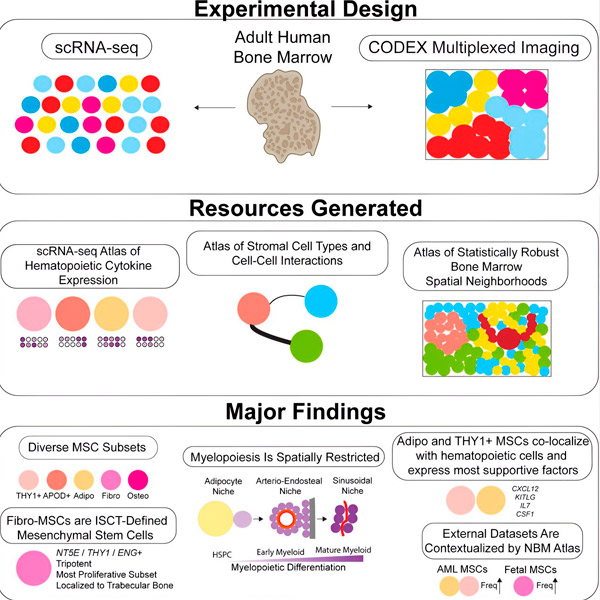Biomolecular Bone Marrow Atlas Provides Unique Insights into Hematopoiesis
Sist anmeldt: 14.06.2024

Alt iLive-innhold blir gjennomgått med medisin eller faktisk kontrollert for å sikre så mye faktuell nøyaktighet som mulig.
Vi har strenge retningslinjer for innkjøp og kun kobling til anerkjente medieområder, akademiske forskningsinstitusjoner og, når det er mulig, medisinsk peer-evaluerte studier. Merk at tallene i parenteser ([1], [2], etc.) er klikkbare koblinger til disse studiene.
Hvis du føler at noe av innholdet vårt er unøyaktig, utdatert eller ellers tvilsomt, velg det og trykk Ctrl + Enter.

Researchers from the Children's Hospital of Philadelphia (CHOP) and the Perelman School of Medicine at the University of Pennsylvania have created a powerful new bone marrow atlas that will provide the public with a first-of-its-kind visual passport to the spectrum of healthy and diseased hematopoiesis. The results were published in Cell magazine.
“For the first time, we will have a comprehensive framework to view the complete gene expression and spatial organization of bone marrow cells,” said senior study author Kai Tang, Ph.D., professor in the department in pediatrics and a researcher at the Center for Children's Cancer Research at CHOP. “Although our paper is fundamental, we envision that the atlas will be used to develop new diagnostic tests, identify new targets for CAR-T therapy and other therapeutic approaches, and discover spatial biomarkers of disease.”
Although the initiative was led by CHOP and Penn, the research is also part of the broader Human BioMolecular Atlas Program (HuBMAP). The HuBMAP consortium consists of 42 different research groups from universities in 14 states and four countries. Researchers are collaborating to create the next generation of molecular analysis technologies and computational tools that will create basic tissue maps and an atlas of the functions and relationships between cells in the human body.
“Research of this magnitude is only possible through a tremendous team effort,” said Showik Bandyopadhyay, Ph.D., lead author of the study and a physician scientist training in Tan's lab. “Through the collaboration of multiple institutions and scientific consortia, we have been able to gain fundamental insight into the microscopic building blocks of the human body.”
Scientists have long theorized that although the majority of bone marrow is composed of blood cells, a small percentage of non-blood cells may play an important role in childhood and adult bone marrow diseases such as leukemia, myeloproliferative disorders, or bone marrow failure syndromes. However, prior to this study, such research had been difficult due to technical problems associated with the rarity and fragility of these cells.
This paper is the first to overcome these limitations and comprehensively profile adult human bone marrow using single-cell RNA sequencing. This technique can capture complete gene profiles of tens of thousands of individual cells, revealing the full composition of cell types that make up an organ.

Source: Cell (2024). DOI: 10.1016/j.cell.2024.04.013
In the study, scientists focused on bone marrow, which regulates important processes in blood cell development and immunity. They identified at least nine subtypes of non-hematopoietic cells, including stromal cells, bone cells and endothelial (blood) cells, at least three of which had not been previously described, and which produced important supportive factors. The researchers have created an encyclopedia of these rare non-blood cells that produce factors thought to be important in human hematopoiesis, which will help better understand which cellular communication future research should focus on.
Their results highlight the increasingly important role of technology in today's biomolecular research. The authors created a spatial atlas of bone marrow comprising about 800,000 cells using a sophisticated new technique called CODEX combined with machine learning. This approach, coupled with careful manual annotation of thousands of cells and structures, allowed them to determine that healthy bone marrow has a very clear spatial organization, and fat cells are more closely associated with hematopoietic cells than previously thought.
"We're just beginning to realize what's possible," Tan said. “Future research can build on our work by accelerating bone marrow research with the hope that these digital pathways will one day lead to medical breakthroughs in the treatment of acute leukemia and other bone marrow diseases.”
Ling Qing, Ph.D., another senior author of this study and a professor of orthopedic surgery at the Perelman School of Medicine, agrees and believes this study will have long-term results.
“When applied to samples from leukemia patients, these techniques detect expansion of mesenchymal cells, a type of rare non-blood cell, at the site of cancer cells in the bone marrow,” Qing said. "This points to a possible new direction for future disease treatment."
